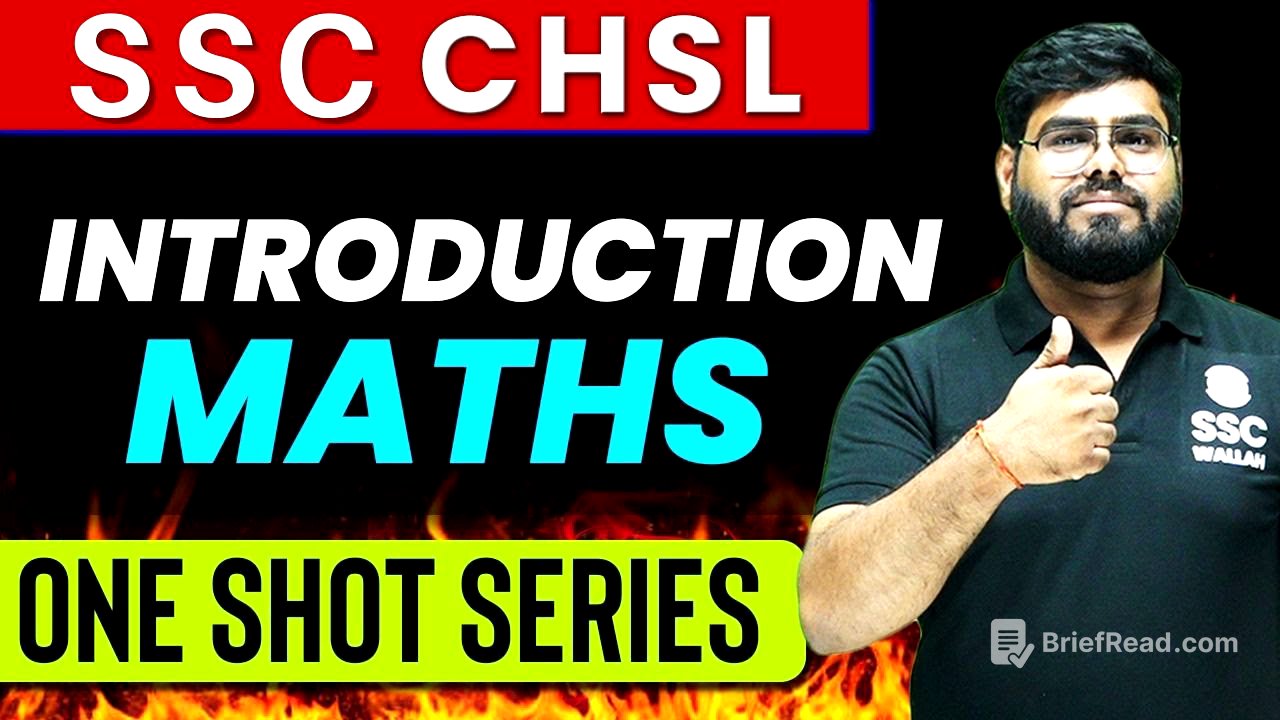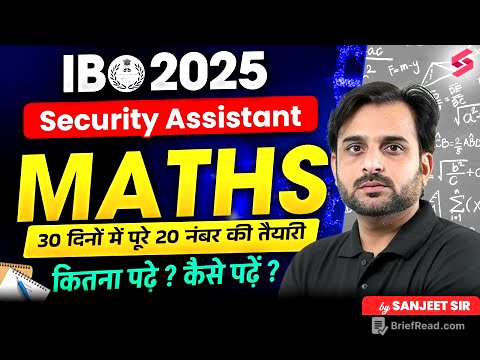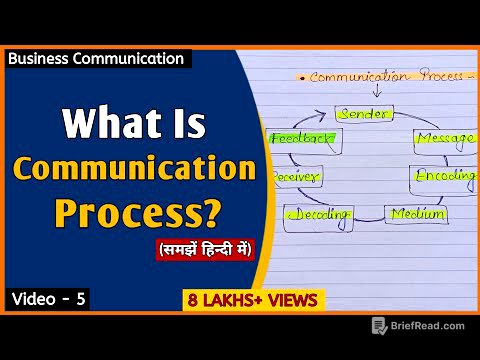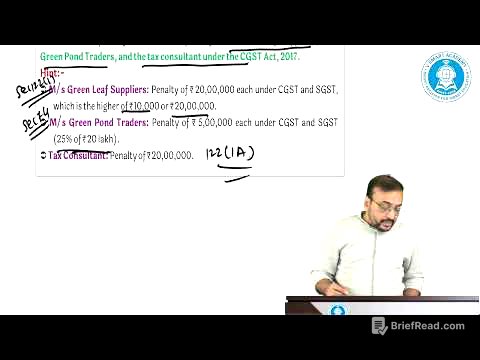TLDR;
This video serves as an introductory session for SSC CHSL exam preparation, focusing on mathematics. It covers eligibility criteria, exam patterns, and syllabus details, emphasizing the importance of understanding the exam structure and key topics. The session also provides insights into effective preparation strategies, including building a strong foundation in calculations and mastering essential concepts.
- SSC CHSL exam details including eligibility, fees, and exam pattern.
- Syllabus overview for mathematics, divided into arithmetic and advanced math.
- Importance of calculation skills and conceptual understanding for exam success.
Introduction to SSC CHSL Exam [0:00]
The session begins by outlining the SSC CHSL examination, which is targeted towards individuals who have completed their 12th grade education. The exam will be available in both Hindi and English. The speaker emphasizes the importance of understanding the exam's agenda, including the syllabus, subject distribution, and the number of tiers involved. The session aims to provide a comprehensive overview of the SSC CHSL examination for aspirants.
All About SSC CHSL [1:17]
The speaker provides detailed information about the SSC CHSL examination, including its full form (Staff Selection Commission Combined Higher Secondary Level). SSC conducts exams for 10th, 12th, and graduation levels, offering various opportunities based on educational qualifications. The SSC CHSL exam is specifically for 12th pass candidates.
Eligibility Criteria and Application Fee [2:44]
To be eligible for the SSC CHSL exam, candidates must have passed 12th grade from any stream (Arts, Science, or Commerce) and be between 18 to 27 years of age. The application fee is ₹100 for candidates belonging to the General and OBC categories. Female candidates and those from reserved categories are exempted from paying the fee. The official notification for the exam is expected to be released on December 6th.
Selection Procedure [5:57]
The selection procedure for the SSC CHSL examination involves three tiers: Tier 1, Tier 2, and Tier 3. Tier 1 is a computer-based test (CBT) with multiple-choice questions. Tier 2 includes descriptive writing, and Tier 3 involves a typing or skill test. Clearing Tier 1 is crucial as it determines progression to subsequent tiers.
Tier One Examination Details [7:48]
The Tier 1 examination includes four subjects: General Intelligence and Reasoning, General Awareness, English Language, and Quantitative Aptitude. Each subject consists of 25 questions, with each question carrying two marks, making a total of 200 marks. The exam duration is 60 minutes, with a negative marking of 0.5 marks for each incorrect answer. The overall cut-off determines selection, and there is no sectional cut-off.
Syllabus for Quantitative Aptitude: Arithmetic [11:35]
The speaker transitions to discussing the mathematics syllabus, dividing it into arithmetic and advanced math. Arithmetic math constitutes 40% of the syllabus, while advanced math covers 60%. Arithmetic topics include percentage, ratio and proportion, profit and loss, simple and compound interest, time and work, average, partnership, speed time distance, boat & stream, mixture & alligation, and data integration.
Syllabus for Quantitative Aptitude: Advanced Math [17:48]
The advanced math syllabus includes topics such as number system, algebra, geometry, trigonometry, height and distance, mensuration (2D and 3D), and coordinate geometry. These topics are crucial for scoring well in the examination, with a weightage of 40% to 55%.
Building a Strong Foundation in Mathematics [22:08]
The speaker emphasizes the importance of building a strong base in mathematics, comparing it to constructing a building. The base of mathematics is calculation, and the pillars are percentage and ratio proportion. A strong foundation in these areas can significantly reduce the difficulty of arithmetic math.
Calculation Techniques and Tricks [25:16]
The session covers various calculation techniques, including addition, subtraction, multiplication, division, square, square root, and tables. Knowing tables up to 20 and prime number tables is essential. The BODMAS rule is also crucial for solving mathematical problems accurately.
The "Same and Ten" Rule [34:40]
The "Same and Ten" rule is introduced as a quick multiplication technique. This rule applies when the first digits of two numbers are the same, and the sum of the last digits is 10. The rule involves multiplying the last digits and then multiplying the first digit by the next number.
Finding Squares of Numbers Ending in 5 [39:06]
A simple method for finding the square of any number ending in 5 is explained. The last two digits of the square will always be 25, and the preceding digits can be found by multiplying the first digit by the next number.
Finding Squares of Two-Digit Numbers [42:23]
The speaker explains a method to find the square of any two-digit number. This involves breaking the number into two parts, squaring each part, multiplying the digits, doubling the result, and then adding the numbers appropriately.
Tricks for Squares Near 50 [46:13]
A trick for finding squares of numbers near 50 is discussed. Knowing the square of 50 (2500) helps in calculating squares of numbers from 41 to 59 by adjusting based on their difference from 50.
Finding Squares of Three-Digit Numbers [50:06]
The method to calculate the square of a three-digit number is explained. The last two digits are underlined, and their square is calculated. The number is then compared to 100, and adjustments are made accordingly.
Multiplication Tricks [58:55]
The session introduces a multiplication trick for alternate numbers. If two numbers have an alternate digital sequence, the product can be found by taking the square of the middle number and subtracting 1.
Importance of Speed and Practice [1:03:14]
The speaker emphasizes the importance of speed in examinations and highlights that practice is the key to increasing speed. Regular practice and incorporating calculations into daily routines are essential for improving mathematical skills.
Conclusion and Future Sessions [1:06:53]
The session concludes by summarizing the topics covered and emphasizing the importance of a structured approach to studying mathematics. Future sessions will include short videos, basic to advanced level content, and a focus on improving calculation skills through practice and meditation techniques. The speaker encourages viewers to stay tuned for upcoming classes and thanks them for their participation.









